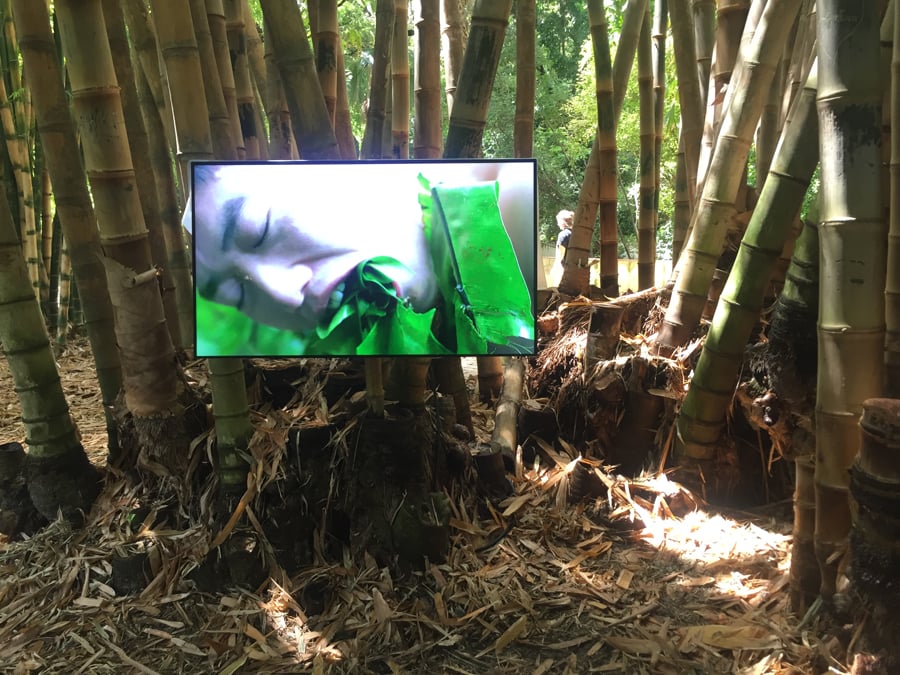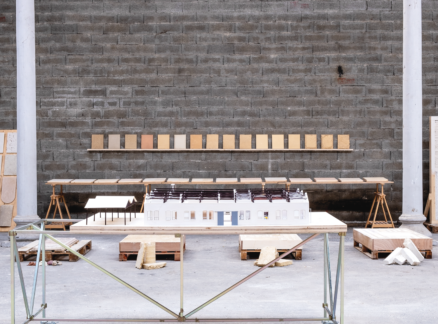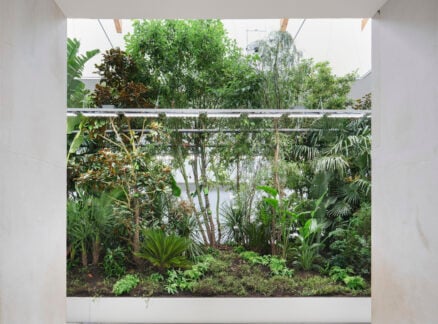
July 11, 2018
Manifesta 12 Uses Art and Architecture to Make Powerful Social Commentary
The collaborative ecosystem of commissioned artists, architects, botanists, activists, journalists, and many others embeds itself into the context of the city, engaging with the cultural palimpsests of Palermo on an intimate scale.

Sited at the center of the Mediterranean, Palermo possesses an architecture that testifies to the comings and goings of different civilizations. An Arab palace can have a Viking facade; a Byzantine church may stand on Roman columns. There are the gardens, too, where citrus trees brought from Asia by North Africans commingle with the prickly pear, plucked from the New World during Columbus’s exploits and brought here by the Spanish. The plump fruits flourish along the roadsides, known to locals as bastardoni—the big bastards.
OMA partner Ippolito Pestellini Laparelli, at the behest of European nomadic biennial Manifesta, recently published these and other observations in Palermo Atlas. Conceived as a comprehensive urban study, the volume attends to more serious concerns of climate change, contemporary migration, tourism, and the Mafia’s historic grip on the city. It also served as the foundation for this year’s Manifesta, which had until now been easily classified as a biennial of contemporary art.
The 12th edition that opened in Palermo in June presents something more ambitious, a global inquiry into hyper-local issues that is both broadly interdisciplinary and tightly curated. Rather than appoint a single curator to the helm, the biennial organizers hired four “creative mediators”: two are architects, Laparelli and Office of Political Innovation founder Andrés Jaque; one is journalist and filmmaker Bregtje van der Haak, and Mirjam Varadinis is the sole art curator. The diverse talent pool resonates with the garden metaphor that appears time and again, most prominently in the exhibition’s title, The Planetary Garden. Cultivating Coexistence. The garden is itself a borderless condition that fosters the productive encounters of species, conjuring images of birds and bees, peace and love.
Floral evocations aside, Manifesta 12 appears amid a deathly serious ongoing political and humanitarian crisis. Just ahead of the biennial’s opening days, the Aquarius, a ship carrying 629 migrants from Africa, appeared off the coast. Following Palermo mayor Leoluca Orlando’s invitation to the city’s port, the Italian interior ministry refused them, a sentence to prolonged misery and uncertainty.

The biennial mines the consequences of extant borders in the weightiest of three thematic sections, “Out of Control Room,” which is sited appropriately in the Palazzo Forcella de Seta, a former bastion in the city walls overlooking the Mediterranean. Inside, where the geometric patterns inlaid into the floor and ceiling nod to the city’s Moorish roots, Forensic Oceanography’s Mare Clausum (2018), or “closed sea,” offers a morbidly clinical analysis of 20 deaths that occurred during a recent botched migrant rescue mission. Produced by an offshoot of the Goldsmiths, University of London–based research team Forensic Architecture, the 29-minute video tracks the play-by-play of the morning of Nov. 6, 2017, using GoPro footage spliced with 3D renderings. You see Berlin NGO Sea Watch respond to a distress signal from a migrant boat, and it’s antagonized by the Italian-backed Libyan Coast Guard as bodies languish in the water. (Sea Watch has entered Libya’s unilaterally declared Search and Rescue Zone, where NGOs are illegal.) Amid the chaos, an affectless voice narrates the exact moment that “one person is left to drown.”
Despite employing architectural tools Mare Clausum is neither architecture nor art. Rather, it’s a plain condemnation of the horrors carried out in the name of enforcing borders, summarizing the distinguishing features of Manifesta 12’s curatorial model. Nearby, videos by filmmaker Laura Poitras and a team of Palermitan collaborators document further tragedies in the Sicilian countryside—covert U.S. military occupations and African migrants trapped in bureaucratic limbo. The screening rooms shroud the palazzo interiors in literal and figurative darkness, painting a global condition either at the brink of eruption or at a freefall into despair. Unrelentingly, they break your heart.
But like any good salad, Manifesta 12 is a panoply of textures and flavors. The factual despair of “Out of Control Room” are tempered by the moments of joy, literal rainbows and sunshine, of “Garden of Flows.” Where the former examines the consequences of borders and the power structures they uphold, the latter section imagines the possibilities of their erasure: What would happen if we relinquished the hierarchies we’ve imposed, not only geographically, but culturally? In the splendor of Palermo’s historic botanical garden, on a monitor somehow installed within a secretive bamboo grove, artist Zheng Bo’s Pteridophilia (2016), presents one libidinous possibility: young men in a Taiwanese forest making loud, impassioned love to the ferns, displaying a form of male intimacy that transcends normative definitions of sexuality. Zheng calls it “eco-queerness.”
Also in “Garden of Flows” is Endless Orchard, a mapping project by the L.A. art duo Fallen Fruit that identifies fruit trees planted on public land, one of the few remaining resources in this world available at zero cost. Copies of the map are available at the 17th-century Palazzo Butera, where the two wrapped a room with wallpaper made from composite images of prickly pear, hybrid lemons, and bitter oranges. The horizontal, citrus-toned gradients of this latter work, Theater of the Sun (2018), evoke a Los Angeles sunset, a reminder that the Americas face parallel conditions: a Mediterranean climate, migration, the recurring threat of drought.
The last of the three exhibition’s thematic chapters, “City on Stage,” peels back the layers of Palermo’s urban condition and proposes coping mechanisms. At the urban periphery, the botanist Gilles Clément, whose 1997 essay, “The Planetary Garden,” informed the curatorial team’s agenda, is cultivating a community garden in a social housing project with design studio Coloco. Elsewhere, Palermo architect Roberto Collovà has erected a facsimile of his studio within the ruins of Palazzo Costantino; it is strewn with the evidence of his ongoing research into the environmental decline of Sicily’s Costa Sud, including piles of detritus—plastics, terra cotta, glass—that he has collected from its beaches. His photographs of the deteriorating coastal community dating back to the 1970s line the crumbling walls..

There’s an obvious resonance between the biennial and Palermo’s political agenda. In his campaign to declare mobility as an inalienable human right, mayor Orlando has been at odds with growing European sentiments towards stemming the tide of migration and sealing off borders. While “Manifesta is a biennial, not the U.N.,” Laparelli concedes, he calls Palermo Atlas a master plan, and the resulting exhibits its “prototypes”—scalable, repeatable, and applicable.
The collaborative ecosystem of commissioned artists, architects, botanists, activists, journalists, and many others embeds itself into the context of the city, engaging with the cultural palimpsests of Palermo on an intimate scale. Manifesta 12 unfolds in a gorgeous parcours among its landmarks and formerly disused buildings, avoiding the exploitative pitfalls of recent biennials. It neither ignores the present crisis nor reduces it to poverty porn. Subverting the function of borders and the power structures they uphold provides a new model of curatorial thinking: no more singular acts of heroic genius.
In the ruins of hubris and unilateral planning, Brussels-based architecture collective Rotor offers remedy in the form of light intervention. On top of Pizzo Sella hill, 30 minutes from the city center by car and then an hour-and-a-half upward climb, the bones of a chaotic urban development the Mafia began 40 years ago sit abandoned. Rotor cleared a path towards it and left the instructions on the side of nearby Palazzo Costantino. (Don’t aggravate the wild boars, it warns.) After taking the scaffolding off of one of the concrete skeletons, they turned the interior into a seated viewing platform with materials from on site. They called the project, Da quassù è tutta un’altra cosa, or “From up here, it’s a whole other story.” Looking down on Palermo, it’s a beautiful one, isn’t it?
You might also like, “How Forensic Architecture Is Harnessing the Power of the Public to Investigate the Grenfell Tower Disaster.”
Recent Viewpoints
Viewpoints
Sustainability News Updates for Q2 2025










